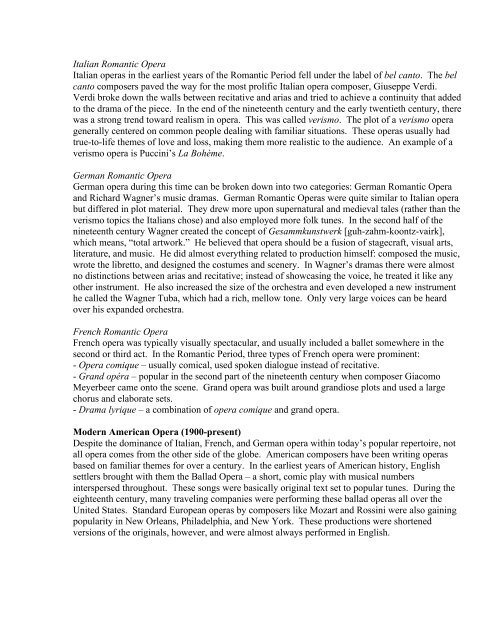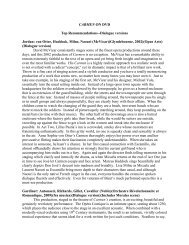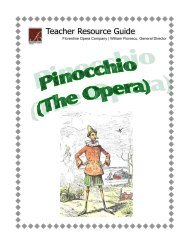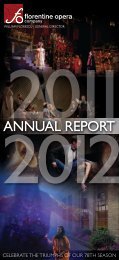Opera In The Know - Florentine Opera
Opera In The Know - Florentine Opera
Opera In The Know - Florentine Opera
Create successful ePaper yourself
Turn your PDF publications into a flip-book with our unique Google optimized e-Paper software.
Italian Romantic <strong>Opera</strong><br />
Italian operas in the earliest years of the Romantic Period fell under the label of bel canto. <strong>The</strong> bel<br />
canto composers paved the way for the most prolific Italian opera composer, Giuseppe Verdi.<br />
Verdi broke down the walls between recitative and arias and tried to achieve a continuity that added<br />
to the drama of the piece. <strong>In</strong> the end of the nineteenth century and the early twentieth century, there<br />
was a strong trend toward realism in opera. This was called verismo. <strong>The</strong> plot of a verismo opera<br />
generally centered on common people dealing with familiar situations. <strong>The</strong>se operas usually had<br />
true-to-life themes of love and loss, making them more realistic to the audience. An example of a<br />
verismo opera is Puccini’s La Bohème.<br />
German Romantic <strong>Opera</strong><br />
German opera during this time can be broken down into two categories: German Romantic <strong>Opera</strong><br />
and Richard Wagner’s music dramas. German Romantic <strong>Opera</strong>s were quite similar to Italian opera<br />
but differed in plot material. <strong>The</strong>y drew more upon supernatural and medieval tales (rather than the<br />
verismo topics the Italians chose) and also employed more folk tunes. <strong>In</strong> the second half of the<br />
nineteenth century Wagner created the concept of Gesammkunstwerk [guh-zahm-koontz-vairk],<br />
which means, “total artwork.” He believed that opera should be a fusion of stagecraft, visual arts,<br />
literature, and music. He did almost everything related to production himself: composed the music,<br />
wrote the libretto, and designed the costumes and scenery. <strong>In</strong> Wagner’s dramas there were almost<br />
no distinctions between arias and recitative; instead of showcasing the voice, he treated it like any<br />
other instrument. He also increased the size of the orchestra and even developed a new instrument<br />
he called the Wagner Tuba, which had a rich, mellow tone. Only very large voices can be heard<br />
over his expanded orchestra.<br />
French Romantic <strong>Opera</strong><br />
French opera was typically visually spectacular, and usually included a ballet somewhere in the<br />
second or third act. <strong>In</strong> the Romantic Period, three types of French opera were prominent:<br />
- <strong>Opera</strong> comique – usually comical, used spoken dialogue instead of recitative.<br />
- Grand opéra – popular in the second part of the nineteenth century when composer Giacomo<br />
Meyerbeer came onto the scene. Grand opera was built around grandiose plots and used a large<br />
chorus and elaborate sets.<br />
- Drama lyrique – a combination of opera comique and grand opera.<br />
Modern American <strong>Opera</strong> (1900-present)<br />
Despite the dominance of Italian, French, and German opera within today’s popular repertoire, not<br />
all opera comes from the other side of the globe. American composers have been writing operas<br />
based on familiar themes for over a century. <strong>In</strong> the earliest years of American history, English<br />
settlers brought with them the Ballad <strong>Opera</strong> – a short, comic play with musical numbers<br />
interspersed throughout. <strong>The</strong>se songs were basically original text set to popular tunes. During the<br />
eighteenth century, many traveling companies were performing these ballad operas all over the<br />
United States. Standard European operas by composers like Mozart and Rossini were also gaining<br />
popularity in New Orleans, Philadelphia, and New York. <strong>The</strong>se productions were shortened<br />
versions of the originals, however, and were almost always performed in English.








